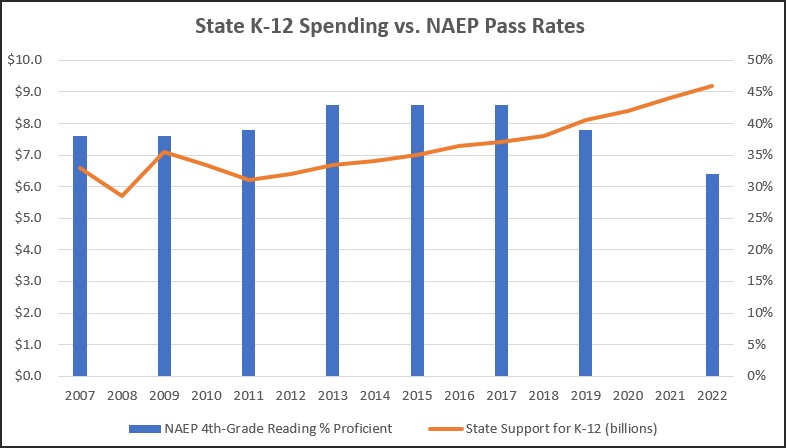
by James A. Bacon
Democrats and the mainstream media were blindsided by the release of National Assessment of Educational Progress (NAEP) data last week showing that 4th graders in Virginia experienced the greatest decline in learning between 2017 and 2022 of any state in the union. I conjectured that the evidence was so conclusive that Virginians could stop debating if public schools had melted down and start acting on the premise that they had.
I was wrong. The defenders of the corrupt and flailing educational status quo are regrouping, and they are criticizing the Youngkin administration’s interpretation of the data as politicized and misleading.
The first counter-attack comes from Jeff Schapiro, the Richmond Times-Dispatch’s veteran capitol correspondent. The headline of his latest column: “Youngkin’s by-the-numbers rant over student performance.”
Describing Youngkin’s spin on the data as “rant” — an irrational tirade — may have been the headline writer’s word choice, not Schapiro’s. Still, the headline fairly captures the negative tone of the column.
Unwilling to credit Youngkin with engaging in honest analysis, Schapiro depicts the Governor as “working overtime” to “depict schools as adrift, teachers as instruments of the woke left, students being indoctrinated and parents as locked out [of] the classroom.” That narrative got him elected in 2021, Schapiro writes, and it could work again for Republicans in 2024. Without saying so outright, Schapiro is suggesting that Youngkin’s presentation of the data is dictated by the narrative.
Schapiro concedes that the NAEP data does provide “fresh fuel” for Youngkin’s arguments. Indeed it does. While most states saw average math and reading scores decline, Virginia 4th graders showed the steepest drop in the country. Virginia 8th graders also lost more ground than students nationally.
The column presents zero evidence to dispute the Governor’s conclusions regarding the precipitous decline in student achievement. Rather, Schapiro offers a different explanation: the “destructive impact of the coronavirus pandemic.” In so doing, he ignores the fact, emphasized by Team Youngkin, that after climbing or remaining stable for a decade, NAEP test scores reversed course and began declining before the pandemic hit.
Schapiro is miffed that Youngkin has ignored all the wonderful things that his gubernatorial predecessors and the General Assembly did for K-12 public education. Like what? Like restoring the cuts to education made in the aftermath of the Great Recession in 2007 and 2009… steering more money toward teacher salaries, school counselors, and early childhood education… holding “conversations” about other reforms such as requiring longer school days, shifting to year-round education, and carving out more time for educational basics.
That’s all very nice, but none of it has any bearing on Youngkin’s interpretation of the data.
There is no correlation between educational performance and the level of state aid to K-12 education. Something else must account for the decline in standardized test scores.
For purposes of analyzing the impact of state funding on 2022 NAEP scores, the relevant comparison is between 2007 and 2022. That fifteen-year period saw a 39.4% increase in state aid to K-12 education compared to 34.5% inflation and 1.7% increase in enrollment. In other words, inflation-adjusted spending per student increased modestly.
In the graph above, I plotted the state-aid expenditures against the trends in NAEP scores. Here’s what we see:
- Between 2007 and 2013 when state aid was flat (and slightly negative adjusted for inflation), NAEP pass rates for 4th graders increased.
- Between 2017 and 2022 when spending was surging, NAEP pass rates collapsed.
What happened after 2017? Increasingly focused on “equity,” the educational establishment under Governor Terry McAuliffe made it a priority to reduce racial/ethnic disparities in educational outcomes. Those changes were working their way through the ponderous Virginia Department of Education approval process when Governor Ralph Northam’s blackface scandal broke and he adopted a radical “woke” agenda to mollify his critics on the left. The same woke currents of thinking were taking hold in Blue strongholds in Northern Virginia, Charlottesville-Albemarle, and old urban centers. Seemingly overnight, schools were subjected to culturally sensitive learning, Diversity, Equity & Inclusion training, more lax restorative-justice disciplinary policies, more forgiving grading policies, lower admissions standards for magnet schools, and lower cut scores in the Standards of Learning tests — all amidst disruptive rhetoric surrounding race and transgender rights.
Ironically, the racial gap has not narrowed since these policies were put into place. It got wider.
To be sure, the COVID pandemic posed immense challenges. But the disruption to learning came not from the virus itself but from the response to the virus. Under the influence of the teacher’s union and its allies in the grip of COVID hysteria, Virginia shifted more aggressively to remote learning than school systems in most other states. The resulting collapse in learning was a policy choice as much as an act of nature.
The architects of these policies will never accept blame for the greatest setback to learning in modern Virginia history. They will throw up endless arguments to distract voters from their culpability. Consider Schapiro’s column a forerunner of rhetorical gambits to come.

Leave a Reply
You must be logged in to post a comment.